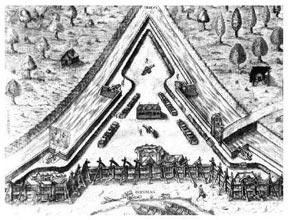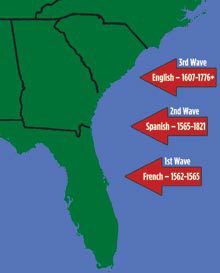Part Nine: Where Was Europe’s First Major Settlement in America?
 Many Americans believe that the first European settlement was St. Augustine. The town claims to be “The oldest continuous city in America.” That is true. But it was not the first planned European settlement. What we discovered was that Spain established St. Augustine in 1565 to be a military outpost to eliminate the French and relay supplies to Santa Elena.
Many Americans believe that the first European settlement was St. Augustine. The town claims to be “The oldest continuous city in America.” That is true. But it was not the first planned European settlement. What we discovered was that Spain established St. Augustine in 1565 to be a military outpost to eliminate the French and relay supplies to Santa Elena.
While St. Augustine was a military outpost, it also had some spouses of the soldiers . . . but it was primarily a military garrison. Spain targeted Santa Elena to be its first colonial capital and its first settlement in America.
 Chester DePratter is South Carolina’s Director of Research for the Institute of Archaeology and Anthropology. He showed me a copy of a letter that King Philip II received from his accountant in 1580. The letter from Lazaro Sanchez de Mercado gives this report of the St. Augustine operation as of March 6, 1580. “There are no settlers here, but only the men of the garrison, who your Majesty pays. If there were, the land is ready for settlement, for although it is a coast, there is a great abundance of mulberry trees for silk. The land also raises sugar cane well.” Albert Manucy reported in his book, “Sixteenth Century St. Augustine,” that by 1580 Santa Elena had sixty houses for settlers.
Chester DePratter is South Carolina’s Director of Research for the Institute of Archaeology and Anthropology. He showed me a copy of a letter that King Philip II received from his accountant in 1580. The letter from Lazaro Sanchez de Mercado gives this report of the St. Augustine operation as of March 6, 1580. “There are no settlers here, but only the men of the garrison, who your Majesty pays. If there were, the land is ready for settlement, for although it is a coast, there is a great abundance of mulberry trees for silk. The land also raises sugar cane well.” Albert Manucy reported in his book, “Sixteenth Century St. Augustine,” that by 1580 Santa Elena had sixty houses for settlers.
The facts speak for themselves. St. Augustine was established in 1565 as a Spanish military garrison. It had few civilian settlers . . . if any. The Spanish planted their flag on Santa Elena in 1566. It was basically a military outpost until 1569 when it became a major settlement. Chester Depratter sent me Spain’s inventory of settlers that lived on Santa Elena in 1569. At that time 190 settlers lived on Santa Elena. When Santa Elena was burned in 1576, some of the settlers temporarily moved to St. Augustine before returning in 1577. In short, Santa Elena was the First Major European Settlement in America. It had 190 settlers by 1569. St. Augustine was a military outpost until 1577. Then it became a temporary settlement. But by 1580 St. Augustine was still a military garrison. It had no settlers. Does this surprise you? It shocked us!

What was the first European settlement in America? Santa Elena was a settlement 11 years before St. Augustine, 38 years before Jamestown, and 51 years before the English pilgrims landed on Plymouth Rock.
First Major European Settlements
In America
• 1569: Santa Elena (Parris Island, SC)
• 1580: St. Augustine, Florida
• 1607: Jamestown, Va.
• 1620: Plymouth, Mass.
What is the history lesson that we are teaching our middle school students? I asked the Beaufort County School District permission to review the history books that our students use today. They loaned me two of the history books that they ask our students to read: “South Carolina – The History of an American State” and “Contemporary World History.” Neither of these history books inform our students of the role that Santa Elena played as the nation’s first major settlement. Neither of them noted that Santa Elena was the first European colonial capital in America. But the South Carolina history book did make this statement on page 101 . . .
“During the 1600s, England established permanent settlements along the coast of the New World. The first colony founded was in Virgnia; the next was in Massachusetts.”
This statement is dead wrong! And it comes from a South Carolina history book. The first colony founded in America was not in Virginia. It was in South Carolina. It was Santa Elena. It was a major settlement by 1569. Jamestown, Virginia was settled in 1607 . . . 38 years later!
How should our children’s American History books read? This is what they should say:
• The first wave of planned settlements started in 1562 when the French established Fort Charlesfort, on Parris Island, and Fort Carolina on the mouth of the St. John’s River in 1564. This French wave was a relatively weak effort to establi’sh a permanent French presence in La Florida.
• Spain’s King Philip II saw these French forts as an invasion of his territory, La Florida. The King believed his La Florida ran from the Keys to Newfoundland and from the Atlantic to the Pacific.
• King Philip responded by making a conquest contract with Pedro Menendez to immediately drive the French out of La Florida and to establish two to three settlements in his claimed colony.
• Menendez responded by planning to make his first settlement Santa Elena . . . on the same Parris Island location that the French used. He chose Parris Island because of the strategic position of Port Royal Sound. It was the best harbor (in depth and width) along the Southern coastline. It was also at the pivot point where the Gold Fleets had to turn toward Spain. It was well positioned to protect the fleet in its most vulnerable position for twenty one years.
• By 1571 Santa Elena was the Capital of La Florida. In the eyes of Spain, La Florida represented all of the territory located in the lower 48 states. The capital of La Florida was moved to St. Augustine after the Indians burned the first Santa Elena town in 1576. However, the town of Santa Elena was rebuilt and resettled in 1577.
• To eliminate the French fort at Fort Caroline, Menendez established St. Augustine as a mi litary outpost in 1565. In the process of driving the
litary outpost in 1565. In the process of driving the
French out of Fort Caroline, Menendez killed France’s Jean Ribault and most of his crews. St. Augustine then became a supply center to establish Santa Elena in 1566.
• To summarize, the first major effort to settle America was Spain’s move to establish St. Augustine and Santa Elena at about the same time. Santa Elena was Spain’s first planned major settlement and the capital of Spain’s La Florida Colony for the first five years. St. Augustine became the nation’s first military garrison and the second major settlement.
• The third major settlement of America happened when Jamestown was settled in 1607.
• The fourth major settlement was Plymouth, Massachusetts. The English Pilgrims landed there in 1620.
One thing is clear. Beaufort County’s Santa Elena is historically at least as important today as St. Augustine, Jamestown or Plymouth Rock. But the problem is this: No one knows this other than a few historians and archeologists.








